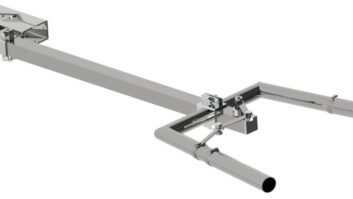A recent Radio World news item reported that Calvary Chapel of Costa Mesa had asked the FCC to eliminate a technical anomaly that comes up when the commission computes interference contours for certain facilities. The story made reference to “invisible” or “buried” FM antennas, terms some readers found confusing.
As noted in the original story, these terms refer to hypothetical structures, not physical antennas. Radio World asked Jack Mullaney, who co-authored the request to the FCC, to explain the concept further. He is president of Mullaney Engineering in Gaithersburg. Put on your contour management thinking hat!
Section 73.215 — Contour Protection for Short-Spaced Assignments — was a desperately needed modification of the rules. It permits stations to propose short-spaced antenna sites with some guarantee that the application will be granted by the FCC staff. Prior to 1989, all short-spacing requests required the FCC staff to evaluate the application and determine if a waiver of the rules was justified. This took up valuable staff resources and thus, the FCC adopted this rule as a “go / no go” test in order to virtually eliminate the need for waiving the spacing table (Section 73.207).
The underlining purpose of this rule section is to insure that integrity of the spacing table (Section 73.207) is maintained — that neither station receives or causes interference and that the other station, the “non-73.215” station, is guaranteed the ability to operate at the maximum facilities (effective radiated power, ERP, and height above average terrain, HAAT) for its Class of FM facility per Section 73.211 of the rules. The station to which the short spacing is being caused should not have its future facilities limited in any way by the station requesting or causing the short spacing.
As such, the non-73.215 station is required to be protected as if it were already operating at the maximum ERP and HAAT permitted by the rules (Section 73.211). Let’s consider a Class C1 FM, permitted to operate with maximum facilities of 100 kW at an HAAT of 299 m. The fact that the station is currently operating with reduced C1 facilities of 70 kW at 100 m HAAT should not prevent it from going to 100 kW at 299 m from its “existing site” just because some other station created a new short spacing to it. So unless the “other” station is already licensed as a 73.215 station, its facilities are to be “maximized.” It should be understood that the non-73.215 station is not detrimentally affected provided that it does not propose to reduce the spacing towards the short-spaced station and provided it does not move to a different site that creates a new short spacing with another FM station.
In areas where the terrain is relatively flat (such as Florida) the maximization process works fine — that is, in areas where the height above ground level (AGL) of the FM antenna is essentially the same magnitude as its HAAT, “maximization” works as intended. Regardless of whether the FM facility is operating with an HAAT above or below the maximum for its Class, maximization works fine.
However, in areas that are mountainous, where the antenna AGL height might only be 50 m but the licensed HAAT is 600 m (substantially different than AGL), 73.215 does not work as intended and as such, it fails to meet the intended goal of providing flexibility in selection of a short-spaced antenna site.
In our example, setting the HAAT to the C1 maximum of 299 m requires the antenna AGL to be lowered by 301 m. As we stated earlier, the FM antenna is only 50 m AGL, so this means that the assumed antenna height is now 251 m “below” the ground elevation of the antenna site. (Here’s where the hypothetical “buried” antenna comes in.) Obviously, this majority of the 600 m HAAT was not due to the AGL height of the antenna but to the fact that the antenna site is on a tall mountain.
Being on a mountain is not really the problem. The issue is that the negative AGL results we get for many of the terrain averages along individual bearings in various directions now are most likely negative HAAT values.
The FCC’s method of computing distance to both the protected and interfering contours does not change for HAAT values that go below 30.5 m or 100 feet. The normally computed distance to a contour for a facility operating with an ERP of 100 kW at an HAAT of 30 m is the “exact” same distance if the antenna HAAT is even lower, say 0 m, –500 m or –1,000 m. Thus, the relative shape of the contour with an assumed antenna height of 251 m AGL “below” the ground elevation can look totally different than it does using the 600 m HAAT, where there may be no negative terrain radials at all. While the shape of both the protected and interfering contours are impacted, the shape of the interfering F(50,10) contour from a co-channel or first-adjacent station to which the short-spacing is being caused is affected most, experiencing the greatest “distortion,” because that contour goes farthest. It should be understood that the FM station filing under Section 73.215 to create the short spacing does not have its facilities maximized since its facilities will forever be analyzed at its “licensed” ERP and HAAT. The station invoking Section 73.215 is no longer entitled to the “assumption of maximum facilities.” Whatever it is licensed for is exactly what it will be protected to.
This has real-world implications.
Our petition to amend Section 73.215 was prepared and filed on behalf of Calvary Chapel of Costa Mesa. They own a Class B FM station, KWVE(FM) in San Clemente, Calif., that created a new short-spacing to another Class B station using the contour protection criteria of section 73.215 of the rules. That other station is not licensed per Section 73.215 and thus, is entitled to “maximization” to preserve its future rights to continue to operate at maximum facilities (even if it is not operating now at the maximum). The center of radiation of its FM antenna mounted at 57 m AGL and this produces an HAAT of 417 m. Because a Class B FM facility is normally limited to 50 kW at 150 m, the rules limit the Class B ERP to 6 kW, since at 417 m HAAT it is equivalent to the maximum coverage permitted (Section 73.211). Maximizing its operation to 50 kW at 150 m essentially results in the other station’s antenna being 210 m “below” the ground elevation (417 minus 150 minus 57 equals 210 m). This below-ground antenna height assumption distorts the distance to the co-channel 34 dBu F(50,10) interference contour of the other station by 12 km.
In Calvary’s specific situation, the 34 dBu interference contour of the other station extends 12 km (7.5 miles) further than the resulting interference contour if the licensed ERP and HAAT were being used in its computation (6 kW at 417 m). As a result, Calvary was required by the rules to utilize a directional antenna that reduces Calvary’s ERP by 10.17 dB or to just 9.6% of its normal ERP. If Calvary were permitted to compute the interference “from” the other station assuming its licensed facilities of 6 kW at 417 m HAAT, Calvary would no longer have to utilize a directional antenna, Calvary would qualify to operate as an omnidirectional facility. The population within Calvary’s protected contour from an omni antenna would increase by over 2.5 million persons.
The proposed modification of Section 73.215 only changes how the interference contour “from” the other station is computed. The method of computing the distance to the other stations protected contour does not change; its protected contour will still be based upon “maximization” for its Class of FM station.
This proposed modification of the rule will restore the flexibility originally intended when the FCC adopted Section 73.215 without introducing any harmful affects on any other FM station.
Want to learn more? Read Mullaney’s engineering presentation here (PDF).












